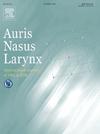复发性呼吸道乳头状瘤病的发病机制及潜在的新治疗策略
IF 1.5
4区 医学
Q2 OTORHINOLARYNGOLOGY
引用次数: 0
摘要
目的探讨由HPV6/11引起的人乳头瘤病毒(HPV)和复发性呼吸道乳头瘤病(RRP)的发病机制、免疫学特性和致瘤性,以及目前可用的治疗策略,确定和探讨潜在的治疗靶点,为今后治疗的发展奠定新的基础。方法使用PubMed和谷歌Scholar,检索词包括“复发性呼吸道乳头状瘤病”“人乳头状瘤病毒”“HPV”“喉乳头状瘤病”,结合关键词“生理学”“治疗”“手术”“辅助治疗”“抗病毒治疗”“基因治疗”,进行全面的文献检索。在寻找可作为参考文献的研究时,没有设定特定的纳入/排除标准,也没有时间限制。结果/讨论HPV感染开始于上皮屏障的破坏,在那里它进入并进入未分化的基底层角质形成细胞,HPV基因组通过产生由早期和晚期基因区域编码的病毒蛋白与宿主细胞相互作用,促进病毒进入、复制和增殖。癌蛋白干扰宿主免疫监视机制,促进生长因子信号传导,创造肿瘤微环境,导致细胞增殖失控和HPV感染的进展。当高危型HPV整合到宿主基因组并积极促进肿瘤发生时,低危型HPV仍然是表面的,具有有限的致癌活性和免疫激活,从而避免炎症诱导和细胞溶解,从而防止显著的抗原产生并促进免疫监视逃避。目前治疗RRP的标准方法是使用激光或冷器械进行手术减体积,并使用或不使用抗病毒药物、干扰素、VEGF/EGFR抑制剂和免疫调节剂等辅助治疗。新的免疫疗法如基因疗法和免疫检查点抑制剂在增强免疫反应和减少手术干预频率方面显示出有希望的结果。结论复发性呼吸道乳头状瘤可逃避宿主免疫反应,复发率高,需要反复手术和药物干预,治疗仍是一个挑战。在目前的治疗标准下,对HPV发病机制的了解的进展为开发新的治疗策略铺平了道路。了解HPV与宿主免疫系统之间细胞和免疫机制的复杂性将为我们未来确定潜在的治疗靶点提供更好的基础。本文章由计算机程序翻译,如有差异,请以英文原文为准。
Pathogenesis of recurrent respiratory papillomatosis and potential novel treatment strategies
Objective
To describe the pathogenesis of human papillomavirus (HPV) and recurrent respiratory papillomatosis (RRP) caused by HPV6/11, immunologic and oncogenic properties, and currently available treatment strategies and to identify and discuss potential treatment targets that can become new foundations for development of future treatments.
Methods
A comprehensive literature search was conducted using PubMed and Google Scholar utilizing search terms which includes “recurrent respiratory papillomatosis” “human papillomavirus” “HPV” “laryngeal papillomatosis” in combination with keywords “physiology” “treatment” “surgery” “adjunct therapy” “antiviral therapy” “gene therapy”. No particular inclusion/exclusion criteria and no chronologic limitation were set during the search for studies to be used as references.
Results/Discussion
HPV infection begins with breaches in the epithelial barrier where it gains entry and access to the undifferentiated basal layer keratinocytes where the HPV genome interact with the host cell through the production of viral proteins encoded by the early and late gene regions facilitating viral entry, replication and proliferation. Oncoproteins interfere with host immune surveillance mechanism, promote growth factor signaling, and create a tumor microenvironment resulting in uncontrolled cell proliferation and progression of HPV infection. While high-risk HPV types integrate into the host genome and aggressively promote oncogenesis, low-risk HPV remain superficial with limited oncogenic activity and immune activation which allows avoidance of inflammation induction and cytolysis thereby preventing significant antigen production and facilitates immunosurveillance evasion. The current standard of treatment of RRP is surgical debulking using lasers or cold instruments with or without and adjuvant therapies like antivirals, interferons, VEGF/EGFR inhibitors, and immunomodulators. Novel immunotherapies such as gene therapies and immune checkpoint inhibitors show promising results in boosting immune responses and reducing the frequency of surgical interventions.
Conclusion
The treatment for recurrent respiratory papillomatosis still remains as a challenge due to its high recurrence rates needing repeated surgical and medical intervention attributed to its capability to evade the host immune responses. With the current standard of treatment, advances in the understanding of HPV pathogenesis paved a way for development of new treatment strategies. Understanding the complexities of the cellular and immune mechanisms involved between HPV and the host immune system will provide us with better foundation in identifying potential treatment targets in the future.
求助全文
通过发布文献求助,成功后即可免费获取论文全文。
去求助
来源期刊

Auris Nasus Larynx
医学-耳鼻喉科学
CiteScore
3.40
自引率
5.90%
发文量
169
审稿时长
30 days
期刊介绍:
The international journal Auris Nasus Larynx provides the opportunity for rapid, carefully reviewed publications concerning the fundamental and clinical aspects of otorhinolaryngology and related fields. This includes otology, neurotology, bronchoesophagology, laryngology, rhinology, allergology, head and neck medicine and oncologic surgery, maxillofacial and plastic surgery, audiology, speech science.
Original papers, short communications and original case reports can be submitted. Reviews on recent developments are invited regularly and Letters to the Editor commenting on papers or any aspect of Auris Nasus Larynx are welcomed.
Founded in 1973 and previously published by the Society for Promotion of International Otorhinolaryngology, the journal is now the official English-language journal of the Oto-Rhino-Laryngological Society of Japan, Inc. The aim of its new international Editorial Board is to make Auris Nasus Larynx an international forum for high quality research and clinical sciences.
 求助内容:
求助内容: 应助结果提醒方式:
应助结果提醒方式:


